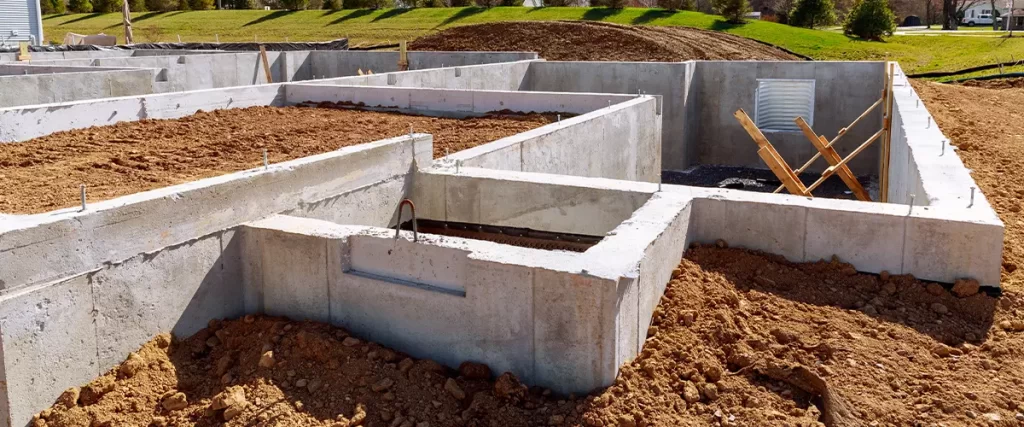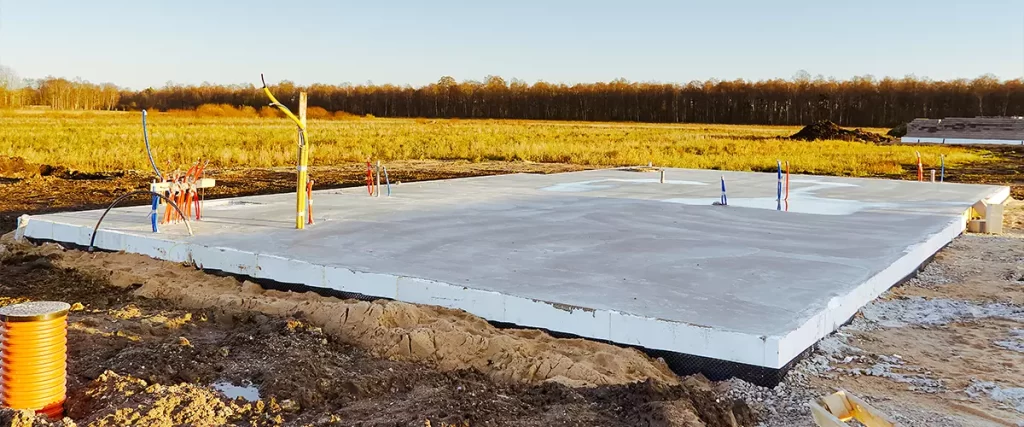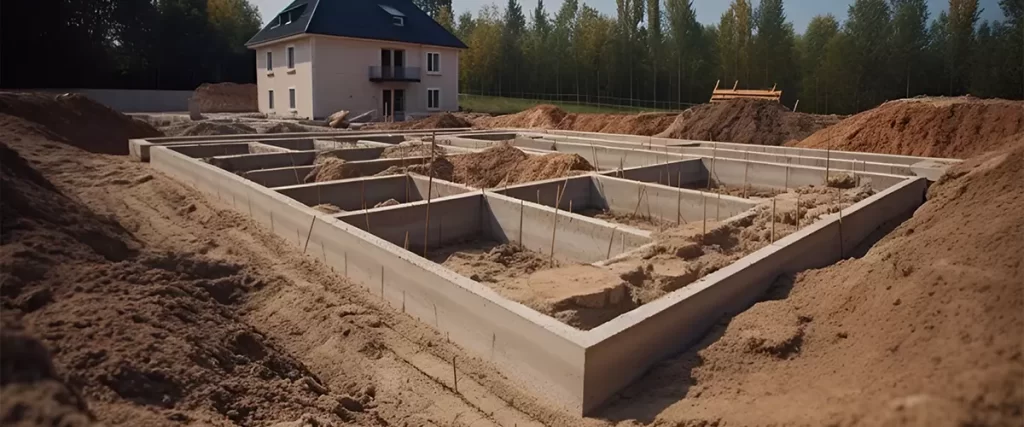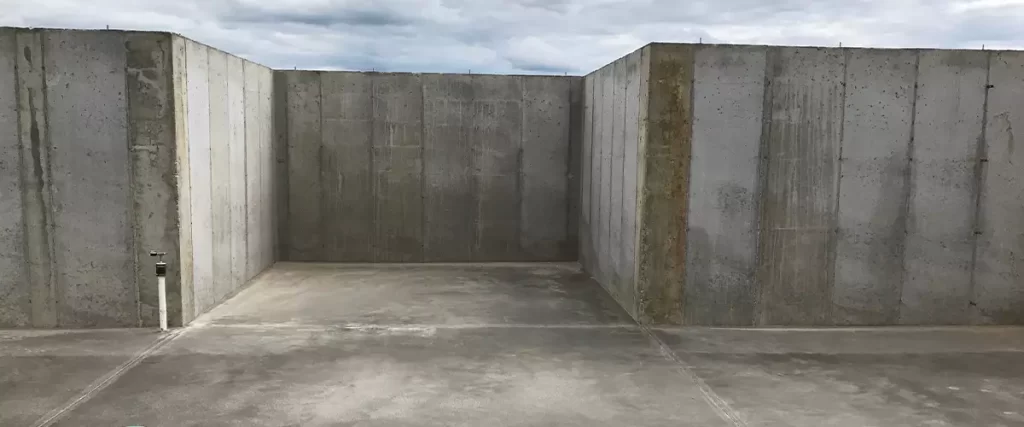Choosing between a slab and a basement can be hard for homeowners. A key fact to know is that both types of foundations have their own pros and cons. This article will guide you through what each foundation offers, from cost to extra space.
Keep reading to learn more.
Key Takeaways
- Slab foundations are cheaper and easier to build than basements. They don’t have extra space underneath but need less work and money over time. Yet, they can crack because of soil or weight problems.
- Basements give more room for living or storage and help keep the house warm or cool. But building them costs a lot, from $18,000 to $30,000 on average. They also face water risks that need care.
- Choosing between slab and basement depends on your area’s weather, ground type, how much you can spend, and what you want from your home. Slabs cost less at first but basements offer more space and use options despite higher prices and flood dangers.

Overview of Slab Foundations
Slab foundations are a type of foundation that directly rests on the ground. They are typically made of concrete and do not have a basement or crawl space underneath.
What is a Slab-on-Grade?
A slab-on-grade is a type of foundation where a concrete slab is laid directly on the ground. This foundation does not have a basement or crawl space underneath. It’s made by pouring concrete into a mold set on the ground level.
Homes built with this foundation rest right on top of this solid platform.
Slab foundations provide strong support for houses in areas with expansive clay soils.
Builders often add extra features like frost protection to make them suitable for different climates. Insulation may also be installed to prevent heat loss through the ground, making homes more energy efficient.
Pipes and plumbing are usually embedded in the slab, which requires careful planning before pouring the concrete.
Key Features of Slab Foundations
Slab foundations are made of a single layer of concrete laid directly on the ground. They don’t have basements or crawlspaces underneath. This type of foundation is common in southern states where the ground doesn’t freeze and frost heaving isn’t a problem.
Slabs need less labor and materials to build compared to other foundations, which makes them cost-effective.
These foundations include features like vapor barriers to keep moisture out. They can also have insulation around their edges to improve energy efficiency. However, slabs can crack if tree roots grow too close or if the soil shifts greatly.
Despite this, many choose slab on grade for its affordability and minimal maintenance needs.
Overview of Basement Foundations
Basement foundations provide additional living space and storage options in a home. The basement floor and walls allow for extra storage space and utility options, expanding the usable square footage of the property.
What is a Basement Foundation?
A basement foundation is a type of concrete foundation that sits below the ground floor of a house. It creates extra storage space or living space. Builders dig deep into the soil, past the frost line, to make room for a basement floor and walls.
Then they use concrete to build these parts strong. This makes sure the house stays stable over time.
Adding a basement can turn your home into a more spacious and functional place.
Basements offer great options like added cost benefits from thermal mass, which keeps homes warmer in winter and cooler in summer. They need things like sump pumps for moisture issues though, especially in areas with high water tables or lots of rain.
Key Features of Basement Foundations
Transitioning from understanding what a basement foundation is, let’s now discuss its key features. Basement foundations are renowned for providing additional living space and storage options in homes.
They typically offer more utility and can be customized to suit various needs, such as creating recreational rooms or accommodating essential utilities.
The structural integrity of basement walls also enhances the overall value of the home. The added square footage can increase property value significantly. It’s essential to acknowledge that construction costs for basements are generally higher compared to other foundation types.
Moreover, there is a risk of water damage with basements due to their below-ground level placement and intricacies around drainage systems.

Pros of Slab Foundations
Slab foundations offer affordability, making them a great idea for cost-conscious homeowners. They also require minimal maintenance, saving you time and money in the long run.
Affordability
Slab foundations are generally more affordable to construct compared to basement foundations. The cost of building a slab foundation is usually lower due to the simpler construction process and the reduction in materials needed, leading to potential cost savings for homeowners.
On average, constructing a slab foundation can save homeowners several thousand dollars in initial construction costs compared to building a basement foundation. This affordability factor makes slab foundations an attractive option for homeowners looking to minimize their upfront expenses when constructing a new home or considering foundation options for their houses built on frost-protected shallow foundations.
Furthermore, the reduced labor and material costs associated with slab foundations contribute to long-term affordability as they often require minimal maintenance and repair expenses over time.
With these cost savings in mind, opting for a slab-on-grade foundation can be a great idea for homeowners seeking budget-friendly alternatives that offer durability and reliability without compromising structural integrity or safety.
Minimal Maintenance
Slab foundations require minimal upkeep, making them cost-effective and convenient for homeowners. Without a crawl space or basement to worry about, there are fewer areas that require regular inspection or repairs.
This leads to lower maintenance costs over the lifetime of the home. Moreover, slab-on-grade construction eliminates the necessity for structural features like floor joists and beams, further decreasing maintenance requirements.
The simplicity of slab foundations means less time and money spent on maintenance.
Transitioning from minimal maintenance to other aspects of foundation types…

Cons of Slab Foundations
Slab foundations can limit storage space and are prone to cracks, potentially leading to structural issues over time. These factors should be considered when deciding on the type of foundation for your home.
Limited Storage Space
Limited storage space is a drawback of slab foundations. Being built directly on the ground, they don’t have basements for extra storage like basement foundations do. Homeowners who opt for slab foundation homes may need to get creative with storage solutions or consider outdoor storage options.
This can sometimes require additional construction, such as adding sheds or outbuildings, which adds to the overall cost of building a home with a slab foundation.
In addition to reduced below-ground storage options, homeowners might also miss out on the flexibility and utility that basements offer in storing seasonal items, household goods, and other possessions that aren’t used frequently but are important enough not to throw away.
Vulnerability to Cracks
Slab foundations are prone to cracking as a result of shifting soil, temperature changes, and inadequate site preparation. In cold climates, frost heave can result in cracking as the ground freezes and thaws.
Moreover, if the slab is not properly reinforced or if substantial weight is placed unevenly, it can develop cracks over time. Employing suitable construction techniques, such as installing control joints and using appropriate reinforcement materials, is essential to reduce the risk of cracks in slab foundations.
Similarly, basement foundations are susceptible to cracks due to factors such as soil movement and hydrostatic pressure from water accumulation around the foundation walls. These pressures can cause concrete cracking and basement wall bowing.
Implementing proper waterproofing measures and drainage systems can help mitigate these vulnerabilities.
Homeowners should be mindful of these potential issues when evaluating different types of foundations for their homes.
Pros of Basement Foundations
Basement foundations provide additional living space for homeowners, expanding the potential uses of their homes. They also offer ample storage and utility options, increasing the functionality of the property.
Additional Living Space
Basement foundations offer valuable additional living space. They provide an opportunity to expand your home, creating extra room for activities or a guest suite. This added space is particularly valuable in homes with limited square footage, offering flexibility and enhancing the overall functionality of your property.
Moreover, basement spaces can be customized to fit various needs such as a home office, entertainment area, or even a dedicated workout space. In areas where land costs are high, using basement space effectively maximizes the value of your property by providing livable square footage without expanding the footprint of the house.
Storage and Utility Options
Transitioning from more living space to storage and utility options, basement foundations offer the advantage of providing extra room for storage and various utility needs. Homeowners can utilize basements as storage for seasonal items, household supplies, or even create a workshop area.
Moreover, it’s an ideal location for housing mechanical systems such as water heaters, HVAC units, or electrical panels due to easy access.
Basements also grant homeowners flexible opportunities to expand their living area through potential conversion into recreational areas or home office spaces. In addition, the cellar provides a cooler environment that can be beneficial for storing perishable goods and wine collections.
Overall, the basement presents versatile options for enhancing both storage capacity and functional use within the household.
Cons of Basement Foundations
Basement foundations can be prone to higher construction costs and the risk of water damage, which may require additional maintenance. These factors should be considered when making a decision about foundation type for your home.
Higher Construction Costs
Basement foundations generally come with higher construction costs compared to slab-on-grade foundations. This is due to the excavation and additional materials required for basement construction.
The need for reinforcing materials, such as concrete walls and waterproofing, contributes to this higher cost. Moreover, if a homeowner wants to utilize the basement space as an additional living area, it will further increase the construction expense.
When comparing numbers, basic construction of a basement foundation typically costs around $10-$25 more per square foot than a slab foundation. For instance, building a 1,500 square foot home on a basement could mean an extra $15,000-$37,500 in initial costs compared to constructing it on a slab foundation.
These figures can significantly impact overall project expenses and are essential factors for homeowners considering their budget constraints when deciding between these two types of foundations.
Risk of Water Damage
Higher construction costs are not the sole consideration when choosing between a slab and basement foundation. Basements may be vulnerable to water damage due to their below-grade construction, making them more susceptible to leaks from heavy rains or groundwater seepage.
This can lead to potential flooding, mold growth, and structural damage if not properly addressed by means of waterproofing systems and proper drainage. Homeowners in areas prone to high water tables or heavy rainfall should carefully assess this risk before opting for a basement foundation.
Waterproofing systems, sump pumps, and proper grading around the foundation are crucial factors in preventing water damage within a basement. Furthermore, homeowners must consider ongoing maintenance costs associated with these preventive measures when determining the type of foundation best suited for their home.
Top Manufacturers of Foundation Materials
When choosing foundation materials, working with reputable manufacturers ensures long-lasting quality and performance for your construction needs.
- Basement Systems Inc. – Known for advanced waterproofing solutions and durable basement materials tailored to resist moisture-related issues.
- Grace Construction Products – Offers premium construction additives and reliable materials ideal for various foundational structures and weather conditions.
- Owens Corning – Provides innovative insulation and structural products designed to enhance energy efficiency and durability in foundation systems.
- Sika Corporation – Specializes in sealing, bonding, and reinforcement materials ensuring foundational integrity and strength for diverse building projects.
- Quikrete – Renowned for its quick-setting concrete and affordable, high-quality products suitable for both slab and basement foundations.

FAQs
1. What is the main difference between a slab and a basement?
A slab is a type of foundation that sits directly on the ground, while a basement provides an additional space below the first floor of your home.
2. How does a frost protected shallow foundation relate to slab homes?
Frost protected shallow foundations are often used in slab homes to prevent damage from freezing temperatures.
3. Does living in a slab home feel different than living in one with a basement?
Yes, some people notice that the floor feels different underfoot in a slab home compared to one with a basement because it’s constructed directly on solid ground.
4. Can I add additional space to my house if it has been built on a slab?
It can be challenging as your first floor rests directly on the concrete foundation without any room for expansion beneath unlike houses with basements which provide extra space.
Experienced Professionals You Can Trust
Our team has been delivering exceptional service for years, ensuring outstanding results. Work with the best to save money and succeed. Contact us at (402) 378-9498 to begin! Get in touch today, and let’s upgrade your space!
